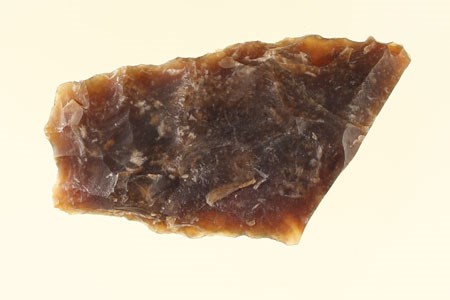Last updated: June 17, 2022
Article
Hopewell Culture Knife River Flint

NPS Photo / Andrew Weiland
Written by Park Guide Sarah Hinkelman
Flint, also known as chert, is a common stone found all over the world. Prehistoric peoples fashioned spear and arrow points, knives, and a wide range of other stone tools from this strong, workable stone. Flint comes in variety of colors depending on the minerals in the stone as it formed. Ancient peoples sometimes exposed flint to heat from fires, further developing more vibrant colors. At Hopewell Culture National Historical Park, archeologists have found a wide variety of flints that were used by the ancient people of the Scioto River Valley. One of the most common flints found in Hopewell sites comes from Flint Ridge, just 70 miles away from Mound City Group. Archeologists have also found flint from much farther away – like Knife River Flint which is almost 1,000 miles away!
The Knife River runs through central North Dakota, exposing large deposits of Knife River Flint cobbles. These cobbles or boulders were quarried or mined from the earth by digging. You can visit one of the largest Knife River Flint quarries, the Lynch Knife River Flint Quarry which is commemorated as a Historic Landmark by the National Park Service. Knife River Flint gets its name from its continual use as a common material for knives for over 13,000 years. The Knife River quarries may be one of the largest and most used flint deposits in North America. They were used by Paleoindians as far back as 11,000 BCE as well as modern day American Indian tribes in the area as recently as 1885 CE.
Knife River Flint is very smooth and is made up of very fine grain crystals that makes it easy to chip and shape into various forms; if you know the proper techniques, that is! This flint has a color very similar to root beer or coffee. Knife River Flint is typically a deep dark brown but can be lighter or darker in some places. The flint can even be slightly translucent. With the help of a UV light, Knife River Flint can be distinguished from many other brown flints. Knife River Flint will glow orange or yellowish grey when exposed to ultraviolet (UV) light, while other flints will not.

NPS Photo / Andrew Weiland
Knife River Flint made its way to the Scioto River Valley as people of the Hopewell culture passed artifacts made of this exotic material between different communities. It seems that many of the Knife River Flint artifacts found in the Scioto River Valley were made elsewhere since there is very little presence of waste materials (debitage or flakes) from the creation of these tools in the area. Knife River Flint artifacts have also been found by archeologists in Hopewell sites from Minnesota to Ohio. Hopewellian groups across North America may have exchanged Knife River Flint, which would have acted to solidify their connection to each other despite the distance between them. Travel across land and by rivers would have been a means for the people of the Scioto River Valley to experience a journey exposing them to various natural wonders; it was likely a spiritual journey for those who participated.
For the people who were a part of the Hopewell culture, items made from Knife River Flint were not for everyday use ... they were special and sacred items. Large blades (knives or spearheads) were likely only used in religious ceremonies and celebrations, similar to the beautiful and exotic obsidian blades sometimes found at Hopewell sites. Knife River Flint artifacts are usually found in burial mounds alongside other ceremonial materials and the remains of important individuals, further marking it as a very special material.
For the people who were a part of the Hopewell culture, Knife River Flint was a material worth waiting for- whether it was the long journey from the West to Ohio by land, river, or through the hands of many peoples along the way. Is there a material like Knife River Flint that we are willing to wait for today?
